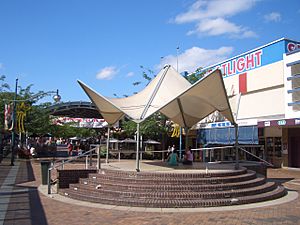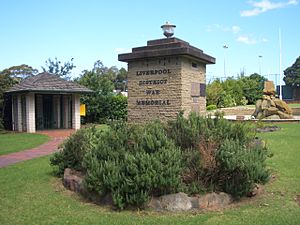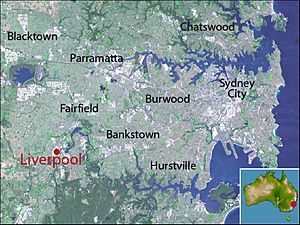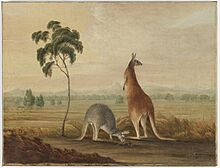Liverpool, New South Wales facts for kids
Quick facts for kids LiverpoolSydney, New South Wales |
|||||||||||||||
|---|---|---|---|---|---|---|---|---|---|---|---|---|---|---|---|
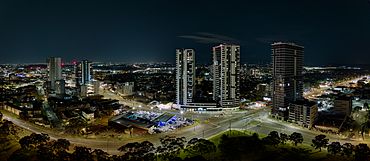
The skyline of Liverpool at night
|
|||||||||||||||
| Population | 31,078 (2021 census) | ||||||||||||||
| • Density | 4,930/km2 (12,800/sq mi) | ||||||||||||||
| Established | 1810 | ||||||||||||||
| Postcode(s) | 2170 | ||||||||||||||
| Elevation | 29 m (95 ft) | ||||||||||||||
| Area | 6.3 km2 (2.4 sq mi) | ||||||||||||||
| Location | 31 km (19 mi) south-west of Sydney CBD | ||||||||||||||
| LGA(s) | City of Liverpool | ||||||||||||||
| State electorate(s) |
|
||||||||||||||
| Federal Division(s) | Fowler | ||||||||||||||
|
|||||||||||||||
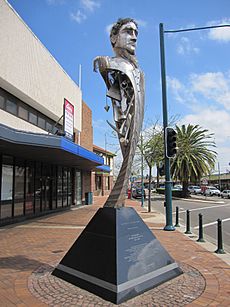
Liverpool is a suburb in South Western Sydney, New South Wales, Australia. It is about 31 kilometers (19 miles) south-west of the Sydney CBD (Central Business District). Liverpool is the main administrative center for the City of Liverpool area. It is located on the Cumberland Plain, a flat area west of Sydney.
Contents
History of Liverpool
Liverpool is one of Australia's oldest towns. It was started on 7 November 1810 by Governor Lachlan Macquarie. He wanted it to be a farming center. He named it after Robert Banks Jenkinson, who was an important British official. The town was also named after the city of Liverpool in England. Some buildings in Liverpool, NSW, even look like those in the English city.
The Post Office in Liverpool opened on 1 March 1825. This was one of the first post offices in New South Wales. Liverpool was also one of the first places to get a telegraph line. A Telegraph Office opened at the railway station in 1858. Later, these two offices joined together.
As Sydney grew, it spread out to Liverpool. Liverpool became an outer suburb of Sydney. It became known for its factories and many homes built for families.
Historic Places in Liverpool
Liverpool has several places that are important for their history. These are called heritage-listed sites. They include:
- 251 Bigge Street: Liverpool Courthouse
- Birkdale Crescent: Collingwood
- College Street: Old Liverpool Hospital
- Elizabeth Drive: St Luke's Anglican Church
- Georges River, Heathcote Road near Newbridge Road: Liverpool Weir
- Great Southern railway: Liverpool railway station
- 17 Speed Street: Rosebank
Shopping and Business in Liverpool
Liverpool is a major city center in South Western Sydney. The city center has a special layout with many small streets and shopping areas. This is similar to the city of Melbourne. Macquarie Street is the main shopping street. It has many small cafes.
Westfield Liverpool is a very large shopping center. It is at the northern end of Macquarie Street. Liverpool Plaza is another shopping mall nearby. The northern part of the city is for tall apartment buildings. The southern part is for large office buildings.
Liverpool has a big teaching hospital. It also has two colleges for technical training. There are many shopping centers and office buildings. Sydney Southwest Private Hospital is also in Liverpool.
Getting Around Liverpool
- Further information: Public transport in Sydney
Liverpool has good road connections. Important roads include the Hume Highway, the M5 Motorway, and the Westlink M7 Motorway.
Liverpool railway station is on the main train line. From Liverpool, you can catch trains to the Sydney city center, Leppington, Parramatta, and Schofields. There is also a special bus route called the Liverpool–Parramatta T-way. This route is only for buses.
You can find more details about buses at the Liverpool station information.
Schools in Liverpool
| St Luke's Anglican Church | |
|---|---|
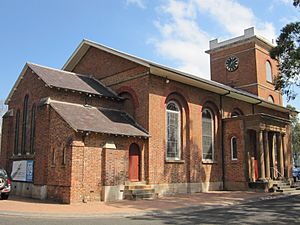
St Luke's Anglican Church
|
|
| 33°55′14″S 150°55′24″E / 33.92065°S 150.92346°E | |
| Location | City of Liverpool |
| Country | Australia |
| Denomination | Anglican Church |
| Website | http://www.stlukesliverpool.org.au/ |
| History | |
| Dedication | 1820 |
| Architecture | |
| Architect(s) | Francis Greenway |
| Groundbreaking | 1818 |
Liverpool has three public primary schools:
- Liverpool Public School
- Liverpool West Public School
- Marsden Road Public School
The two public high schools are Liverpool Boys High School and Liverpool Girls High School. Mainsbridge School helps children with learning disabilities. Liverpool Hospital School is for children who are in the hospital for a long time.
Private schools in Liverpool include All Saints Primary School, All Saints Catholic College, and Al Amanah College.
For education after high school, there is:
- South Western College of TAFE (technical and further education)
- Macarthur Community College
- Liverpool U3A: School for Seniors
- University of Western Sydney English Language Centre
- School of Arts in Macquarie Street
- University Of Wollongong
Places of Worship
Many different religions have places of worship in Liverpool.
- St Luke's Anglican Church is in the city center. It is the oldest Anglican church still standing in Australia.
- All Saints Catholic Church is on George Street, near the All Saints schools.
- St Raphael, Nickolas and Irene Greek Orthodox Church is on Forbes Street.
- The Serbian Orthodox Church of the Apostle Luke is on Flowerdale Road.
- Ganzibra Dakhil Mandi is a Mandaean temple in the city center. It is the largest Mandaean temple in Australia.
Sports and Fun in Liverpool
Parks and Green Spaces
Liverpool has many open spaces for recreation.
- Bigge Park has a War Memorial.
- Pioneer Memorial Park has a historic cemetery.
- Woodward Park is a big sports area. It has playing fields and the Whitlam Leisure Centre. The Leisure Centre has a swimming pool and a large indoor sports stadium.
- Other sports places include Collimore Park (for netball) and Paciullo Park (for soccer and touch football).
Sports Teams
Liverpool is home to several sports teams:
- Fairfield-Liverpool Cricket Club plays in the Sydney Grade Cricket competition.
- Liverpool City Netball has done well in state competitions.
- Hinchinbrook Hornets Junior Rugby League.
- FC Bossy Liverpool plays in the New South Wales Super League.
- Liverpool Rangers FC is at Ireland Park.
- The West Sydney Razorbacks basketball team used to play here.
- The Sydney Ice Dogs ice hockey team plays at the Liverpool Catholic Club Ice Rink.
- Liverpool also has a little athletics club.
Media and News
Liverpool has an arts and creation center. It offers music lessons for instruments like guitar, drums, and banjo.
Liverpool has a local radio station, 89.3FM 2GLF. It shares local news, music, and programs for different cultures. It was one of the first FM radio stations in the area.
Liverpool has had newspapers since the late 1800s.
- The first newspaper was The Liverpool Times in 1886.
- Then came The Liverpool Mercury.
- Both later joined with The Liverpool Herald.
- The Liverpool News was a free newspaper from 1904 to 1973.
Today, Liverpool has two newspapers: The Liverpool Leader and The Liverpool Champion. Both are published every Wednesday.
People of Liverpool
In 2021, Liverpool had 31,078 people. Many people in Liverpool come from different countries. Less than one-third (33.9%) were born in Australia. The next most common birthplaces were Iraq (11.3%), India (4.9%), Vietnam (3.1%), Fiji (2.7%), and Philippines (2.2%).
About 24.6% of people speak only English at home. Other languages spoken include Arabic (19.2%), Serbian (6.5%), Vietnamese (4.4%), Hindi (3.2%), and Urdu (2.4%).
Many people in Liverpool follow a religion. Only 12.1% said they had no religion. The most common religions were Islam (16.4%), Catholic (16.2%), and "Miscellaneous Religions" (9.2%).
Famous People from Liverpool
- Mark Bosnich, a former soccer player
- Michael Clarke, a cricketer
- Sir Jenkin Coles, an auctioneer and politician
- Walter Hampson Cooper, a journalist and politician
- Isaac De Gois, a rugby league player
- Mitchell Duke, a soccer player
- Michael Dwyer, an Irish leader and early police chief in Liverpool
- Nathan Foley, a former member of the group Hi-5
- Frederick Augustus Forbes, a store-keeper and politician
- Scott Gardiner, the first golfer of Aboriginal background to play on the PGA Tour
- Liam Hatcher, a cricketer
- Vic Hey, a rugby league player
- Brett Hodgson, a rugby league player
- Harry Kewell, a soccer player
- Craig Knowles, a politician
- Terry Lamb, a rugby league player
- Anthony Minichiello, a rugby league player
- Mark Minichiello, a rugby league player
- Brad Morrin, a rugby league player
- Pat Richards, a rugby league player
- Richard Sadleir (1794–1889), Liverpool's first mayor in 1872
- Lenny Zappavigna, a boxer
Geography and Climate
The natural plant life in Liverpool includes the Cooks River/Castlereagh Ironbark ecological community and Cumberland Plain Woodland. You can still find small parts of these original forests in the area.
Liverpool's Climate
- Further information: Climate of Sydney
Liverpool has a humid subtropical climate. This means it has warm, humid summers and mild winters. Liverpool is usually a few degrees warmer than the Sydney CBD during the day. However, nights in Liverpool can be a bit cooler than in central Sydney. For example, if it's 27°C in the city, it might be 33°C in Liverpool. In winter, temperatures can get close to 0°C in Liverpool, while it stays above 7°C in central Sydney.
The hottest day ever recorded in Liverpool was 45.8°C on 1 February 1977. The coldest temperature recorded was -5°C on 25 July 1994.
Rainfall is spread out through the year. The first half of the year tends to be wetter. July to September are usually drier months. Frost can happen in winter.
| Climate data for Liverpool, New South Wales, 1962-2014 | |||||||||||||
|---|---|---|---|---|---|---|---|---|---|---|---|---|---|
| Month | Jan | Feb | Mar | Apr | May | Jun | Jul | Aug | Sep | Oct | Nov | Dec | Year |
| Record high °C (°F) | 45.6 (114.1) |
45.8 (114.4) |
41.0 (105.8) |
37.1 (98.8) |
29.6 (85.3) |
25.9 (78.6) |
26.8 (80.2) |
30.5 (86.9) |
35.4 (95.7) |
39.8 (103.6) |
43.3 (109.9) |
43.5 (110.3) |
45.8 (114.4) |
| Mean daily maximum °C (°F) | 29.7 (85.5) |
28.7 (83.7) |
27.2 (81.0) |
24.2 (75.6) |
21.2 (70.2) |
18.4 (65.1) |
17.9 (64.2) |
19.9 (67.8) |
23.3 (73.9) |
24.9 (76.8) |
26.6 (79.9) |
28.2 (82.8) |
24.2 (75.5) |
| Mean daily minimum °C (°F) | 17.7 (63.9) |
17.8 (64.0) |
15.2 (59.4) |
12.0 (53.6) |
8.0 (46.4) |
5.9 (42.6) |
4.2 (39.6) |
4.8 (40.6) |
8.3 (46.9) |
10.8 (51.4) |
14.4 (57.9) |
16.1 (61.0) |
11.3 (52.3) |
| Record low °C (°F) | 7.8 (46.0) |
9.4 (48.9) |
5.0 (41.0) |
3.2 (37.8) |
−1.5 (29.3) |
−2.0 (28.4) |
−5.0 (23.0) |
−3.0 (26.6) |
−1.8 (28.8) |
3.3 (37.9) |
4.7 (40.5) |
7.8 (46.0) |
−5.0 (23.0) |
| Average precipitation mm (inches) | 52.6 (2.07) |
153.6 (6.05) |
65.7 (2.59) |
59.6 (2.35) |
53.9 (2.12) |
76.3 (3.00) |
34.8 (1.37) |
22.4 (0.88) |
35.6 (1.40) |
54.0 (2.13) |
74.6 (2.94) |
65.9 (2.59) |
749 (29.49) |
| Average precipitation days (≥ 1 mm) | 7.2 | 9.1 | 7.6 | 7.1 | 5.7 | 7.1 | 6.1 | 3.4 | 4.4 | 6.6 | 8.2 | 7.7 | 80.2 |
| Source 1: Liverpool (Whitlam Center) | |||||||||||||
| Source 2: Liverpool (Michael Wenden Center) | |||||||||||||
See also
 In Spanish: Liverpool (Australia) para niños
In Spanish: Liverpool (Australia) para niños


